Digital Poster
MRS, EPR & Hyperpolarization I
Joint Annual Meeting ISMRM-ESMRMB & ISMRT 31st Annual Meeting • 07-12 May 2022 • London, UK

| Computer # | ||||
|---|---|---|---|---|
1073 |
80 | Reproducibility of multi-slice MR spectroscopic imaging of GABA at 3 T
Helge Jörn Zöllner1, Ipek Özdemir1, Dillip K. Senapati1, Michal Považan2, Georg Oeltzschner1, Kimberly Chan3, Doris D. M. Lin1, and Peter B. Barker1,4
1Russell H. Morgan Department of Radiology and Radiological Science, The Johns Hopkins University School of Medicine, Baltimore, MD, United States, 23 Danish Research Centre for Magnetic Resonance, Hvidovre Hospital, Copenhagen, Denmark, 3Advanced Imaging Research Center, University of Texas Southwestern Medical Center, Dallas, TX, United States, 4F. M. Kirby Research Center for Functional Brain Imaging, Kennedy Krieger Institute, Baltimore, MD, United States
Reproducibility of multi-slice GABA-edited MRSI of the human brain recorded at 3T was investigated in 6 healthy adult volunteers, with and without a retrospective motion compensation scheme applied (MoCo). Overall reproducibility was good with improved performance when MoCo was applied (relative GABA+/tCr difference between visits: 20.8% no Moco, 10.0% with MoCo). Retrospective MoCo is a viable alternative for edited-MRSI when prospective motion correction is unavailable, at least in relatively compliant subject groups.
|
||
1074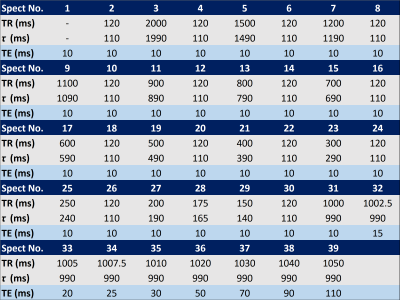 |
81 | Investigating liver fibrosis using water T1 estimated by flip angle corrected multi-parameter MRS
Ashley L Louie1, Gavin Hamilton1, Alexandra N Schlein1, Walter C Henderson1, Danielle N Batakis1, Lael K Ceriani1, Yesenia Covarrubias1, Tanya Wolfson1, Nikolaos Panagiotopolous2, David T Harris2, McMillan Alan2, Daiki Tamada2, Kathryn J Fowler1, Scott B Reeder2, and Claude B Sirlin1
1Radiology, University of California, San Diego, La Jolla, CA, United States, 2Radiology, University of Wisconsin, Madison, WI, United States
The purpose of this study was to examine the relationship between water T1 and T2 estimated by Flip Angle Corrected Multi-Parameter (CMP) MRS and biopsy-determined fibrosis. The sample of twenty-eight subjects with biopsy and MRS data is part of a dual-center, weight loss surgery study. Subjects without fibrosis were found to have significantly higher CMP MRS T1 water values than patients with fibrosis.
|
||
1075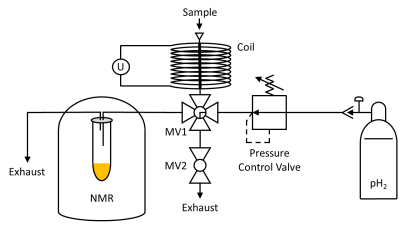 |
82 | On the experimental setup of parahydrogen-induced polarization via proton exchange. Video Permission Withheld
Jule Kuhn1, Kolja Them1, and Jan-Bernd Hövener1
1Section Biomedical Imaging, Molecular Imaging North Competence Center (MOIN CC), Department of Radiology and Neuroradiology, University Medical Center Schleswig - Holstein, Kiel University, Kiel, Germany The PHIP-X methodology is a novel approach to hyperpolarize nuclei from specific molecules that could function as contrast agents in metabolic MRI. PHIP-X combines the strong polarization of hydrogenative PHIP with the broad applicability of proton exchange and opens up the variety of potential hyperpolarizable biomolecules. The presented experimental setup facilitates the application of pH2 pressures up to 30 bar and well-defined external magnetic fields up to 80 mT. Using this setup allowed to hyperpolarize glucose (830 mM) and achieved increasing polarization with increasing the pressure from 10 bar to 20 bar (molar polarization was more than doubled). |
||
1076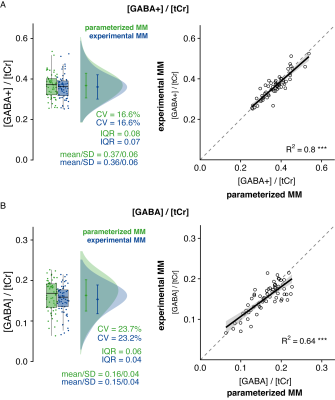 |
83 | GABA-edited MEGA-PRESS at 3T: Does a measured MM background improve linear-combination modeling?
Helge Jörn Zöllner1,2, Yulu Song1,2, Steve C. N. Hui1,2, Peter B. Barker1,2, Richard A. E. Edden1,2, and Georg Oeltzschner1,2
1Russell H. Morgan Department of Radiology and Radiological Science, The Johns Hopkins University School of Medicine, Baltimore, MD, United States, 2F. M. Kirby Research Center for Functional Brain Imaging, Kennedy Krieger Institute, Baltimore, MD, United States
Recent work identified a 'best practice' linear-combination modeling (LCM) strategy for GABA-edited spectra using parameterized basis functions for co-edited macromolecules. Here we introduce a measured macromolecular basis function to evaluate possible improvements in the modeling.
|
||
1077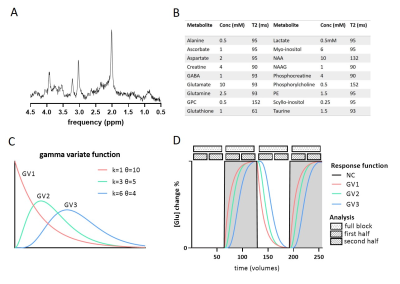 |
84 | The effect of the glutamate response function on detection sensitivity for functional MRS: a simulation study
Anouk Schrantee1, Adam Berrington2, Petra J Pouwels1, Bram F Coolen3, Oliver Gurney-Champion1, and Chloé F Najac4
1Department of Radiology and Nuclear Medicine, Amsterdam University Medical Centers, Amsterdam, Netherlands, 2Sir Peter Mansfield Imaging Centre, School of Physics and Astronomy, University of Nottingham, Nottingham, United Kingdom, 3Department of Biomedical Engineering and Physics, Amsterdam University Medical Centers, Amsterdam, Netherlands, 4C.J. Gorter Center for High-Field MRI, Department of Radiology, Leiden University Medical Center, Leiden, Netherlands
fMRS stimulation paradigms and analysis strategies are highly heterogeneous, partially due to lack of knowledge of the underlying metabolic response function. To better understand the potential consequences of analysis methods, this simulation study evaluates the effect of different glutamate response functions (GRFs) and binning strategies. As the GRF becomes more delayed, analyzing bins from spectra directly after ‘task’ onset results in underestimation of the true change. In moving average analyses, the fitted time-courses co-varied significantly with the input glutamate time-course. Future simulation studies will expand on other variable sources, such as habituation and hemodynamic effects, and macromolecule fitting procedures.
|
||
1078 |
85 | Improved motion compensation for water-suppressed diffusion MR Spectroscopy evaluated using synthetic data
André Döring1, Derek K Jones1, and Roland Kreis2,3
1Cardiff University Brain Research Imaging Centre (CUBRIC), Cardiff University, Cardiff, United Kingdom, 2Magnetic Resonance Methodology, Institute of Diagnostic and Interventional Neuroradiology, University Bern, Bern, Switzerland, 3Translational Imaging Center, sitem-insel, Bern, Switzerland
We demonstrate that, even without having water as an internal reference, a combination of spectral registration and fitting can restore artificial signal loss promoted by incoherent averaging due to frequency/phase drifts and motion-induced dephasing for the cardinal brain metabolites (tCr, tCho, tNAA, Glx and Ins) by using a set of synthetically distorted diffusion MR spectra (including realistic phase, frequency and amplitude fluctuations).
|
||
1079 |
86 | Reproducibility of localized 31P-MRS methods using different surface coils for assessment of hepatic metabolism in vivo at 3T
Marc Jonuscheit1,2, Stefan Wierichs1,2, Yuliya Kupriyanova1,2, Michael Roden1,2,3, and Vera Schrauwen-Hinderling1,2,4
1Institute for Clinical Diabetology, German Diabetes Center, Leibniz Institute for Diabetes Research at Heinrich Heine University, Düsseldorf, Germany, 2German Center for Diabetes Research (DZD e.V.), München-Neuherberg, Germany, 3Department of Endocrinology and Diabetology, Medical Faculty, Heinrich Heine University, Düsseldorf, Germany, 4Department of Radiology and Nuclear Medicine, Maastricht University Medical Center, Maastricht, Netherlands We determined day-to-day variation and intra-session reproducibility of 31P-MRS-based hepatic phosphorus metabolite quantification. To this end, we compared a standard single loop with a custom-created quadrature surface coil. Absolute concentrations of γ-adenosine triphosphate and inorganic phosphate were assessed in 7 volunteers with both coils. Both coils showed comparable day-to-day and intra-session CVs < 10 %. Metabolite concentrations determined by the two coils were similar. Therefore, both coils yield robust absolute concentrations of hepatic phosphorous metabolites. The quadrature coil allows measurements at a higher distance from the coil which can be important for the application in obese patients.
|
||
1080 |
87 | MultiNet CAIPIRINHA: accelerated 1H MRSI with 1-step neural network reconstruction based on augmented MRSI training data
Kimberly L Chan1 and Anke Henning2,3
1Advanced Imaging Research Center, The University of Texas Southwestern, Dallas, TX, United States, 2The University of Texas Southwestern, Dallas, TX, United States, 3Max Planck Institute for Biological Cybernetics, Tübingen, Germany
We have shown that MultiNet, a neural-network-based image reconstruction, can reconstruct variable-density k-space undersampling schemes to decrease MRSI acquisition times. This used a 4-step method where points are predicted by 4 successively-applied neural-networks off both acquired and previously predicted k-space points. Herein, a 1-step method where points are only predicted off acquired k-space points to reduce reconstruction error was explored. This method was trained using a new augmented MRSI training set and compared to the 4-step reconstruction of new CAIPIRINHA-based schemes and the original schemes. The new 1-step reconstruction method was found to increase SNR and improve metabolic maps.
|
||
1081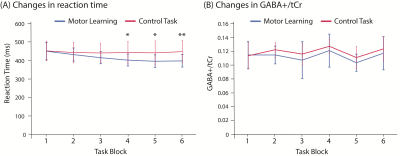 |
88 | Functional changes in GABA during motor learning with GABA-editing at 3T
Tiffany K Bell1,2,3, Alexander R Craven4,5, Kenneth HugDahl4,6,7, Ralphe Noeske8, and Ashley D Harris1,2,3
1Department of Radiology, University of Calgary, Calgary, AB, Canada, 2Hotchkiss Brain Institute, University of Calgary, Calgary, AB, Canada, 3Alberta Children's Hospital Research Institute, University of Calgary, Calgary, AB, Canada, 4Department of Biological and Medical Psychology, University of Bergen, Bergen, Norway, 5Department of Clinical Engineering, Haukeland University Hospital, Bergen, Norway, 6Division of Psychiatry, Haukeland University Hospital, Bergen, Norway, 7Department of Radiology, Haukeland University Hospital, Bergen, Norway, 8GE Healthcare, Berlin, Germany
Functional magnetic resonance spectroscopy (fMRS) of GABA at 3T is challenging due to the difficulties of measuring GABA levels; GABA is present in the brain at relatively low concentrations and its signal is overlapped by higher concentration metabolites. Here we use a continuous MEGA-PRESS acquisition to show changes in GABA levels measured in the sensorimotor cortex during motor learning and during a control button pressing task. This indicates GABA levels can be tracked during a functional experiment, allowing fMRS of GABA to be accessible at 3T, the more commonly used field strength.
|
||
1082 |
89 | Mapping of apparent Intra- and extra-myocellular lipid content using spiral spectroscopic imaging and diffusion imaging at 3T
Antoine Naëgel1,2, Magalie Viallon1, Jabrane Karkouri1,2,3, Thomas Troalen2, Kevin Moulin1,2, Pierre Croisille1, and Hélène Ratiney1
1Université de Lyon, INSA-Lyon, Université Claude Bernard Lyon 1, UJM-Saint Etienne, CNRS, Inserm, CREATIS UMR 5220, U1206, Lyon, France, 2Siemens Healthineers, Saint-Denis, France, 3Wolfson Brain Imaging Center, University of Cambridge, Cambridge, United Kingdom Exploring spatial distribution of intra- and extramyocellular lipids linked to the orientation of muscle fibers is complex. We used a magnetic resonance spectroscopic imaging (MRSI) technique with a spiral encoding of k-t space and diffusion imaging tractography at 3T to reveal possible concomitant factors. The IMCL preponderance index, exploiting the spectroscopic dimension and proposed in this study, highlights interesting and relevant patterns in some calf muscle heads. |
||
1083 |
90 | A simulation framework to assess the quantification reliability of 2HG in 1H MRS
Justyna Platek1,2, Vanessa L. Franke1,2, Mark E. Ladd1,2,3, Peter Bachert1,2, and Andreas Korzowski1
1Division of Medical Physics in Radiology, German Cancer Research Center (DKFZ), Heidelberg, Germany, 2Faculty of Physics and Astronomy, University of Heidelberg, Heidelberg, Germany, 3Faculty of Medicine, University of Heidelberg, Heidelberg, Germany
The non-invasive detection of 2-hydroxyglutarate (2HG) via 1H MRS is of particular interest in brain tumors, but quantification of 2HG may be challenging due the spectral overlap with Glutamate and Glutamine. In this study, we implemented a simulation framework for the assessment of the quantification reliability for 2HG under realistic conditions, and demonstrated its application to a PRESS sequence at B0=9.4T with a representative set of different TEs and SNR levels. With this framework, we aim to identify optimal acquisition parameters for the detection of 2HG in glioma mouse models at a 9.4-T small animal scanner in the future.
|
||
1084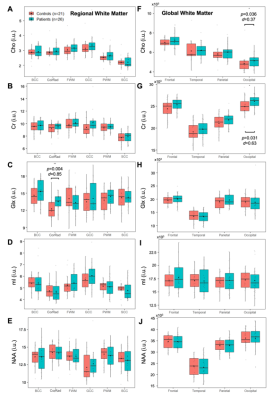 |
91 | Replicability of 1H MR spectroscopic imaging in mild traumatic brain injury
Anna M Chen1, Teresa Gerhalter1, Seena Dehkharghani1,2, Rosemary Peralta1, Fatemeh Adlparvar1, Martin Gajdošík1, Mickael Tordjman1,3, Julia Zabludovsky1, Sulaiman Sheriff4, Sinyeob Ahn5, James S Babb1, Tamara Bushnik6, Alejandro Zarate6, Jonathan M Silver7, Brian S Im6, Stephen P Wall8, Guillaume Madelin1, and Ivan I Kirov1,2,9
1Center for Biomedical Imaging, Department of Radiology, New York University Grossman School of Medicine, New York, NY, United States, 2Department of Neurology, New York University Grossman School of Medicine, New York, NY, United States, 3Department of Radiology, Cochin Hospital, Paris, France, 4Department of Radiology, University of Miami Miller School of Medicine, Miami, FL, United States, 5Siemens Medical Solutions USA Inc., Malvern, PA, United States, 6Department of Rehabilitation Medicine, New York University Grossman School of Medicine, New York, NY, United States, 7Department of Psychiatry, New York University Grossman School of Medicine, New York, NY, United States, 8Ronald O. Perelman Department of Emergency Medicine, New York University Grossman School of Medicine, New York, NY, United States, 9Center for Advanced Imaging Innovation and Research, Department of Radiology, New York University Grossman School of Medicine, New York, NY, United States
1H-MRS has the potential to provide biomarkers for mild traumatic brain injury (mTBI), a diagnosis in which damage is often imaging-occult, but a lack of replicability and reproducibility studies hampers clinical translation. Here, we tested the replicability of previous MRSI results in mTBI with a different patient cohort. Five out of seven hypotheses were consistent with previous work, with key findings of globally diffuse white matter (WM) injury and limited gray matter injury. However, we report differences in choline and creatine, not N-acetyl-aspartate. Correlations were found between metabolite levels in WM and both symptomatology and neuropsychological testing.
|
||
The International Society for Magnetic Resonance in Medicine is accredited by the Accreditation Council for Continuing Medical Education to provide continuing medical education for physicians.